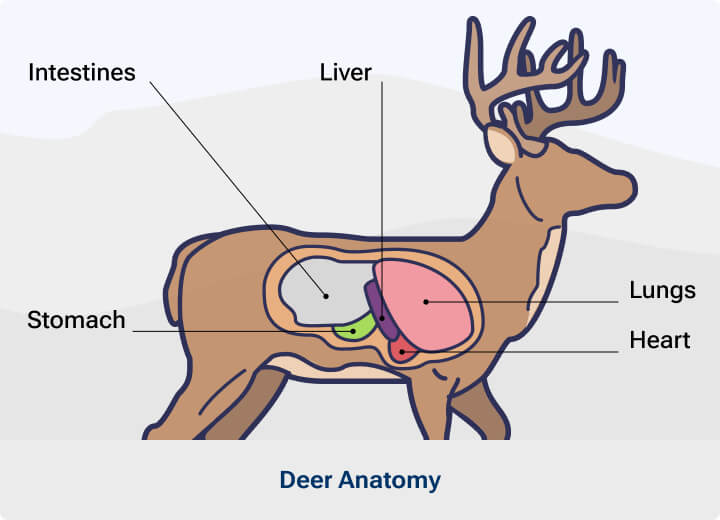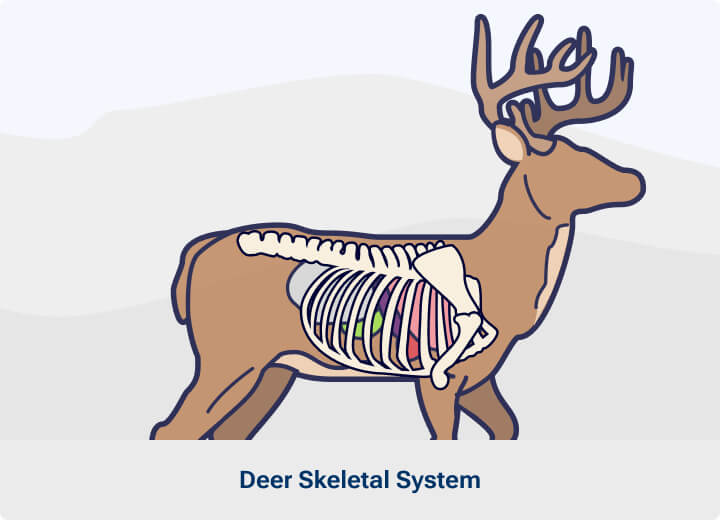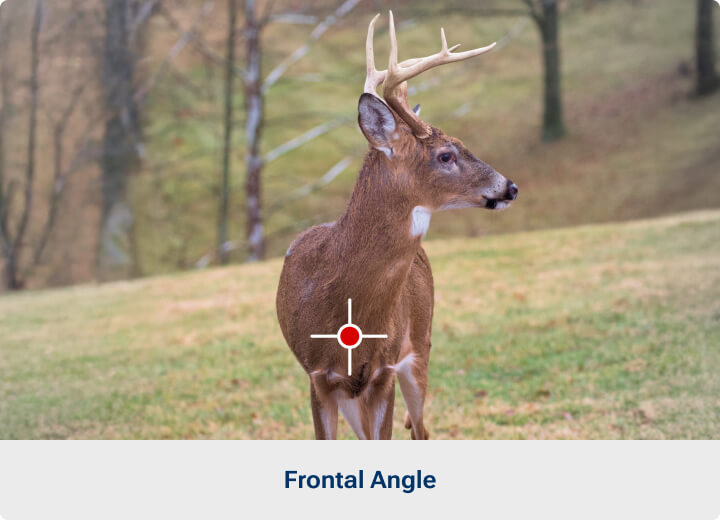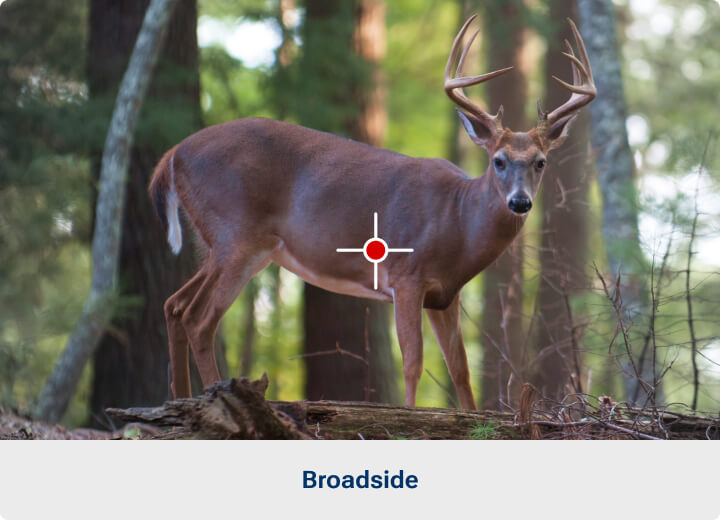Deer Shot Placement Guide

When it comes to hunting deer, shot placement is key to making a clean, ethical shot that ensures a quick, humane harvest. In this guide, we'll explore deer anatomy and the best places to shoot a deer for a successful hunt.
Key Takeaways
- Deer Anatomy — Familiarizing yourself with deer anatomy, including the vital organs and skeletal structure, can help you find the best place to shoot a deer.
- What is the Best Deer Shot Placement? — The best deer shot placement is the lungs because they are a larger target that results in a humane kill. Reference our deer shot placement chart to find the shot that matches your skill level.
- Where to Shoot a Deer Based on Angles — Discover the best deer shot placement based on how a deer is facing you, whether you’re using a bow or firearm, and the angle from which you’re shooting.
- Shooting a Deer Head Up vs. Head Down — It’s best to shoot a deer when its head is up because it can’t react to your movements or weapon as quickly as when its head is down.
Deer Anatomy
Understanding deer anatomy is crucial for effective shot placement because it helps you aim for areas that result in a quick, humane kill rather than unnecessary suffering. Simply put, knowing deer anatomy helps you become a more responsible and effective hunter. We’ve outlined the parts of the deer you should know below.
Vital Organs

Hitting a deer’s vital organs is the fastest, most humane way to take them down. It also improves your recovery rate because you’re less likely to have to track down a wounded target. You should aim for its heart or lungs.
The heart is a fatal deer shot placement, but it’s very difficult to hit because it’s a small target, and the aim can be thrown off by the deer’s movement. Because of this, it’s typically best to aim for the lungs. They’re lined up, increasing the likelihood of hitting one or both and quickly killing the deer.
Skeletal System

A deer’s vital organs are protected by its skeletal system, which can make shot placement difficult. However, getting through the tissue, muscle, and bones is the only way to hit the deer’s vital organs. The main bones hunters must contend with are the shoulder, scapula, spine, and rib cage.
- Shoulder and Scapula: Extremely tough and difficult to put a bullet through. Try to avoid this shot placement.
- Spine: Difficult because it’s a very thin target that moves with the deer. It’s an instant takedown shot but typically only achieved by pros.
- Rib Cage: Guards the heart and lungs. Aiming just behind the shoulder blade helps avoid the rib cage and hit the vital organs.
What is the Best Deer Shot Placement?
The best deer shot placement is the lungs because it’s the largest kill zone. This means there’s room for error while still achieving an ethical kill. Hitting both lungs with one shot (a double-lung shot) is extremely effective and downs deer quickly. It’s more forgiving than a heart shot, but it still requires precision and anatomy knowledge.
Deer Shot Placement Chart
To help you find the best shot placement on deer quickly, we’ve compiled your options. Be sure to consider your experience level and the shot’s fatality before using one in the field.
| Deer Shot Placement | ||||
|---|---|---|---|---|
| Shot Placement | Recommended For | Fatal | Takedown Time | Shot Risk |
|
Lungs |
All hunters |
✔ |
Fast |
Low |
|
Heart |
Hunters with some experience |
✔ |
Fast |
Low |
|
Neck |
Hunters with some experience |
✔ |
Medium |
Medium |
|
Spine |
Experienced hunters |
✔ |
Medium |
High |
|
Head |
Experienced hunters |
✔ |
Fast |
High |
|
Abdomen |
Hunters with some experience |
✘ |
Slow |
Medium |
|
Leg |
Experienced hunters |
✘ |
Slow |
High |
Where Not to Shoot a Deer
Where you shouldn’t shoot a deer largely depends on your experience and the hunting situation. However, you should avoid areas that are not fatal because they can cause unnecessary suffering and increase the chances of game escaping. We recommend avoiding the stomach, leg, hind, tail, and — in most cases — the spine, a deer shot placement best left to experienced hunters.
Expert Tip:
“When bow hunting the best shot angle is
without a doubt a slightly quartering away shot! You want to hit all soft tissue
with this shot so it allows you to hit more vital organs and in most cases get a
pass through. This angle keeps you from also running the risk of hitting the
animal in the front shoulder, making penetration much more difficult. If you get
the pass through you have two holes instead of just one hole allowing for a much
better blood trail if needed! Be patient and wait for the right shot and don't
force it and your kill rate will go way up when bow hunting! ”
— Deer Hunting
Expert, Mike Stroff
Where to Shoot a Deer Based on Angles
Deer are always moving, making where you’re shooting from (distance and angle) just as important as where you’re aiming. Deer use their exceptional sight, hearing, and smell to detect threats and sprint away at any sign of danger, meaning you must always be alert and able to understand where and why to adjust your shot angle.
Quartering Away

If a deer is quartering away, it’s facing away from you with its rear closer to you without fully obscuring its side. For a clean, ethical kill, aim behind the last rib on the near side. This allows the bullet or arrow to travel through the body cavity and reach the heart and lungs.
Quartering Toward

In the quartering toward angle, the deer faces you at an angle, putting its head toward you without fully obscuring its side. You should aim for the front of the shoulder nearest to you while avoiding the bone.
Frontal

In the frontal angle, the deer is facing directly toward you, taking its side completely out of sight. This leaves little room for error and requires a steady hand. You should aim for the center of the chest, just below the base of the neck. Be careful not to hit the shoulder bones.
Broadside

The last — and most preferable — angle a deer can face is broadside. This is when the deer’s side is facing you. It exposes the heart and lungs and gives you a larger target area. There are two areas within broadside shots hunters go for: behind the shoulder and the ‘Vital V.’
If you choose the behind the shoulder shot placement, line the firearm up with the deer’s front leg and aim for the middle between its belly and back. The Vital V shot targets the front of the lungs and the top of the heart. There are many vital arteries housed here, so the deer will go down fast if you aim correctly.
Deer Shot Placement Considerations
There are a few scenarios that may change the best deer shot placement. We’ve outlined a few tips on how to handle them below.
| Deer Shot Placement Considerations | ||||
|---|---|---|---|---|
| Scenario | Quartering Away | Quartering Toward | Frontal | Broadside |
|
Bow Hunting |
|
|
|
|
|
Firearm Hunting |
|
|
|
|
|
Shooting From Eye Level |
|
|
|
|
|
Shooting From an Elevated Position |
|
|
|
|
Shooting a Deer Head Up vs. Head Down
This is an age-old debate about how quickly a deer can react to the sound of a firearm with its head up or down. Although deer with their heads up may seem more alert, their hearing is better than their eyesight. So, when their heads are down, their ears are their main means of threat detection. This means that deer with their heads down can react faster to a weapon firing, making it easier for them to escape.
The same is true when hunting deer using a bow and arrow. When a deer’s head is down, it’s more likely to "string jump," meaning it reacts to the sound of your shot by dropping its body to prepare for a quick escape. This can make your shot miss high. When a deer’s head is up, it’s less likely to drop as dramatically, which makes your shot more predictable.
Because of this, it may be best to shoot a deer when its head is up. Regardless, deer shot placement remains the same. Always anticipate a bit of movement after your shot and aim accordingly.
Have Fun Out There!
In the end, mastering deer shot placement is key to being a responsible and successful hunter. Take your time, make the right shot, and enjoy the rewarding experience of a well-placed hunt. If you’re ready to embark on your next adventure, browse the wide selection of hunting gear and equipment available at Academy Sports + Outdoors!


